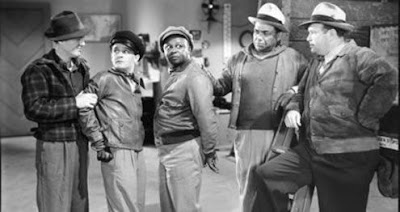Starring: Dick Merrill, Paula Stone, Weldon Heyburn, Jack Lambie, Milburn Stone, and Ivan Lebedeff
Director: William Nigh
Rating: Five of Ten Stars
Real-life, record-breaking pilots Dick Merrill and Jack Lambie star as test-pilots and daredevils who undertake a dangerous cross-Atlantic flight to deliver life-saving medicine to the engineer who designed their latest stunt plane (Heyburn). Before that, though, one them develops a hate/love/hate relationship with a beautiful and wealthy dilletante aviatrix/stunt-pilot groupie (Stone).
"Atlantic Flight" was one of the first productions mounted after Monogram Pictures was reestablished in the wake of a ill-fated merger with Republic Pictures and an ensuing court battle. In 1937, Dick Merrill and Jack Lambie were minor celebrities for having broken some flight records. Monogram's executives hoped that building a film around them is about average for a Monogram Pictures release. In the plus column, it's got a swift moving plot that's mostly logical in the way it unfolds; all the characters we're expected to like are actually likable; and the stock footage from airshows and Merrill and Lambies actual history-making trans-Atlantic flight.
Given that this is a Monogram Pictures production from the 1930s, ones sits down to watch it assuming it's either going to be a lot of fun, or it's going to be a tedious exercise in stagey acting and questionable writing. In the final analysis, "Atlantic Flight" is about average for what the studio offered during this time.
On the plus side, this is a fast-moving film with a mostly sensible plot; the characters we're supposed to like are generally likable and the acting is pretty good all around; and the aviation documentary/stock footage is so well-integrated with the scenes that surround it you can't tell it was not originally part of the film.
On the negative side, the fast-paced script has a number of flaws. The primary among these are that the subplot of the film's villain being wrapped up with aflashing a headline across the screen instead of actual story-content; the supporting character of Pokey (played by Milburn Stone, who would later go onto a 20-year stint as Doc on "Gunsmoke") is more interesting than any of the alleged lead characters; and the event of the title comes so late in the film so as to almost feel like an afterthought... and then it's motivated by such outlandish reasoning that it almost seems silly.
"Atlantic Flight" is an innocuous bit of fluff that tried to latch onto long-forgotten celebrities of its time. It's main appeal for modern audiences is limited to its pleasant and talented cast... although those with an interest in the histor of aviation might find it fascinating for the included real-life footage.
You can watch the film straight from this post by clicking below!





















.jpg)














.jpg)






.jpg)
